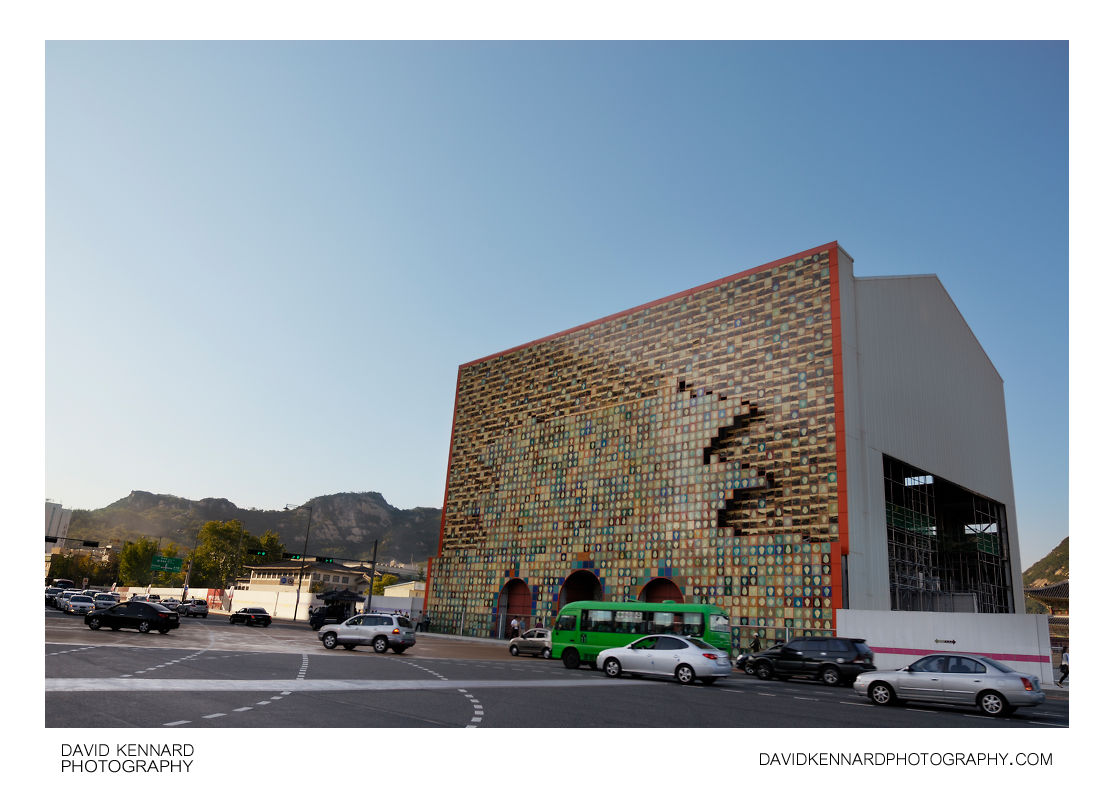Gwanghwamun under reconstruction

Description
- Title:
- Gwanghwamun under reconstruction
- Caption / Description:
-
Gwanghwamun (Hangul: 광화문; Hanja: 光化門) is the main and largest gate of Gyeongbokgung Palace, located in Seoul, South Korea. As a landmark and symbol of Seoul's long history as the capital city during the Joseon Dynasty, the gate has gone through multiple periods of destruction and disrepair. Recent restoration work on the gate was finished in October 2010.
Gwanghwamun was first constructed in 1395 as the main gate to Gyeongbokgung Palace, the main and most important royal palace during the Joseon Dynasty. During the 1592 Japanese Invasion, it was destroyed completely by the Japanese.
However, Gwanghwamun was reconstructed in 1867 along with the rest of Gyeongbokgung Palace by the order of regent Daewongun during the reign of Emperor Gojong. The gate stood until 1926, when the Japanese government had it deconstructed and moved it just to the southeast of the current location of the National Folk Museum of Korea to make way for the massive Japanese Governor General Building.
The Korean war completely destroyed the wooden structure of Gwanghwamun, and its stone base lay in complete disrepair and neglect. In 1963, during Park Chung-hee's administration, the stone base was again relocated in front of the Japanese Governor General Building. The destroyed wooden structure was rebuilt in concrete, while the sign on Gwanghwamun was written by Park himself. Gwanghwamun remained as a concrete gate until late 2006.
Gwanghwamun is currently undergoing restoration, which started in December, 2006 and expected to finish in October 2010. The gate is being disassembled and moved back to its original location 14.5 meters to the south, and its wooden structure is again reconstructed in wood. It will also be rotated in order to accurately place the gate to its original location, which is perfectly aligned with the main north-south axis of Gyeongbokgung Palace. The restoration was commenced by the Korean government because an earlier attempt at restoration, the gate had been reconstructed from concrete whilst it was also wrongly aligned with the entrance of the Governor General Building, now destroyed.
The aim of the current renovation is to restore Gwanghwamun, the main gate of Gyeongbokgung Palace, to its original wooden construction with meticulous historical accuracy. The sign of Gwanghwamun was recreated by analyzing its century-old glass plate photographs, while its wooden structure was made from a blueprint created in 1925 by the Japanese Colonial Government. Pine wood used in the construction was painstakingly picked in Korea as the use of foreign imported wood for historic buildings was strictly forbidden.
The area in front of Gwanghwamun, also known as Gwanghwamun Plaza, was opened in September 2009.
Description taken from Wikipedia article: http://en.wikipedia.org/wiki/Gwanghwamun
- Tags / Keywords:
-
- Asia
- 한국
- Hanguk
- 韓國
- Korea
- Seoul Special City
- Seoul Teukbyeolsi
- 서울特別市
- 서울특별시
- Jongno-gu
- 종로구
- 鐘路區
- Reconstruction
- 광화문
- 光化門
- Gyeongbok Palace
- 경복궁
- Gyeongbokgung
- 景福宮
- Gwanghwamun
- Gwanghwamun Intersection
- Rennovation
Admin
- Date Original Photo Taken:
- Original File Name:
- Gwanghwamun under reconstruction.psd
- Event:
- Rating:
- ☆☆
- Date this image added/last updated on website:
- Original File Dimensions:
- 3864px x 2598px
- File Type:
- JPEG
- Color Mode:
- RGB
- Original Image Color Profile:
- Nikon Adobe RGB 4.0.0.3001
Location
- Location Shown:
-
- Sublocation:
- Gwanghwamun
- City:
- Jongno-gu
- Province/State:
- Seoul
- Country:
- Korea, Republic Of
- World Region:
- Asia
- Location Created:
-
- Sublocation:
- Gwanghwamun Intersection
- City:
- Jongno-gu
- Province/State:
- Seoul
- Country:
- Korea, Republic Of
- World Region:
- Asia
- Geo-location:
- 37.57540075, 126.97723883333 View on map
Rights
- Copyright Status:
- Copyrighted
- Licensing Status:
- Rights Managed
- Available for Editorial Use:
- Yes
- Available for Commercial Use:
- No
- Copyright Notice:
- © 2009 Dave Kennard
Camera Data
- Date Digital Resource was created:
- Shutter speed:
- 1⁄90 s
- Aperture:
- f/7.1
- Camera Model:
- Nikon D200
- ISO:
- 100
- Exposure Compensation:
- +1
- Focal Length:
- 18mm
- Focal Length (35mm equiv.):
- 27mm
- Metering Mode:
- Multi-segment
- Flash:
- No Flash
- Exposure Mode:
- Auto
- White Balance:
- Manual
- Light Source:
- Cloudy
- Exposure Program:
- Aperture-priority AE
Additional shooting metadata
- Lens:
- Nikon AF-S DX Zoom Nikkor ED 18-70mm F3.5-4.5G(IF)
- Filters used:
-
- B+W UV 010 MRC
- Additional Optics used:
- Setup:
- Handheld, bracketed ±1EV
Post Processing
- Image Modified:
- Software used:
-
- Adobe Photoshop CS4
- Nikon Capture NX 2
- Post Processing:
NEFs converted in Capture NX 2
Exposures blended in Photoshop CS4
Bit of hair from person standing nearby removed from left side of image in Photoshop CS4
Selective Curves adjustment to warm up colour temperature in Photoshop CS4
Curves adjustment to increase contrast in Photoshop CS4
